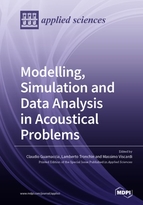Modelling, Simulation and Data Analysis in Acoustical Problems
A special issue of Applied Sciences (ISSN 2076-3417). This special issue belongs to the section "Acoustics and Vibrations".
Deadline for manuscript submissions: closed (31 December 2018) | Viewed by 130008
Special Issue Editors
Interests: acoustics; environmental acoustics; room acoustics; field measurements; modeling and simulation; data analysis
Special Issues, Collections and Topics in MDPI journals
Interests: acoustics; room acoustics; musical acoustics; emulation of nonlinear acoustic systems; 3D auralisation; multiple arrays in 3D acoustic measurements; noise barriers
Special Issues, Collections and Topics in MDPI journals
Interests: acoustic; finite element method; structural dynamics; SHM; vibration analysis and testing
Special Issues, Collections and Topics in MDPI journals
Special Issue Information
Dear Colleagues,
Modelling and simulation in acoustics problems are gathering more and more importance. In fact, with the development and improvement of innovative computational techniques, and with the growing need for predictive models, an impressive boost has been observed in this domain. The design of a model needs a proper conversion of reality to functions and parameters. On the other hand, once a model has been designed, an adequate simulation must be run, in terms of modelling and computational parameters. Keeping in mind the limitations and the approximations of any model, data analysis, both online and offline, is the last step of this process and can be extremely important to extract the required output from the process. This Special Issue is aimed at the collection of original research papers on theoretical and applicative studies on acoustics modelling, simulation, and data analysis. An interdisciplinary approach is encouraged. Research topics to be considered for a valid submission are all the issues related to the above description. Authors are invited to submit their work related to the following topics (but not limited to them):
-
Modelling and Simulation in Environmental Acoustics
-
Modelling and Simulation in Room Acoustics
-
Modelling and Simulation in Musical Acoustics
-
Online and offline data analysis
-
Predictive model implementation and validation
-
Residuals and Error evaluation and statistics
-
Signal analysis and parameters evaluation
-
etc.
Prof. Dr. Claudio Guarnaccia
Prof. Dr. Lamberto Tronchin
Prof. Eng. Massimo Viscardi
Guest Editors
Manuscript Submission Information
Manuscripts should be submitted online at www.mdpi.com by registering and logging in to this website. Once you are registered, click here to go to the submission form. Manuscripts can be submitted until the deadline. All submissions that pass pre-check are peer-reviewed. Accepted papers will be published continuously in the journal (as soon as accepted) and will be listed together on the special issue website. Research articles, review articles as well as short communications are invited. For planned papers, a title and short abstract (about 100 words) can be sent to the Editorial Office for announcement on this website.
Submitted manuscripts should not have been published previously, nor be under consideration for publication elsewhere (except conference proceedings papers). All manuscripts are thoroughly refereed through a single-blind peer-review process. A guide for authors and other relevant information for submission of manuscripts is available on the Instructions for Authors page. Applied Sciences is an international peer-reviewed open access semimonthly journal published by MDPI.
Please visit the Instructions for Authors page before submitting a manuscript. The Article Processing Charge (APC) for publication in this open access journal is 2400 CHF (Swiss Francs). Submitted papers should be well formatted and use good English. Authors may use MDPI's English editing service prior to publication or during author revisions.
Keywords
-
Acoustics
-
Vibration
-
Environmental acoustics
-
Room Acoustics
-
Modelling
-
Simulation
-
Data Analysis
-
Error evaluation and metrics








